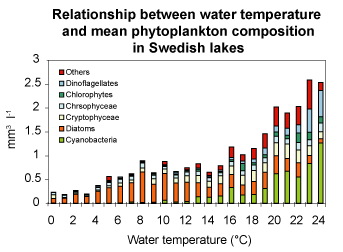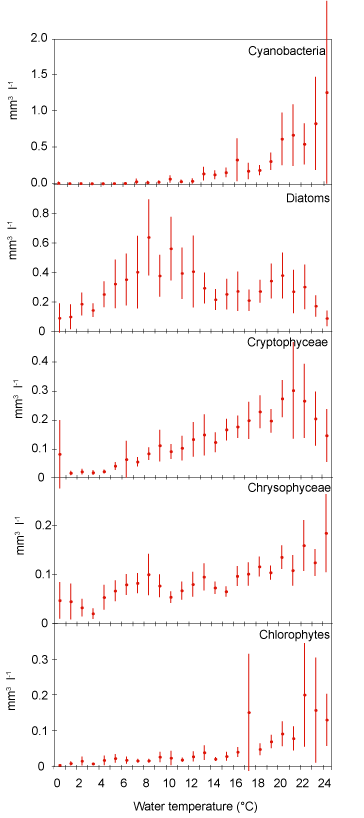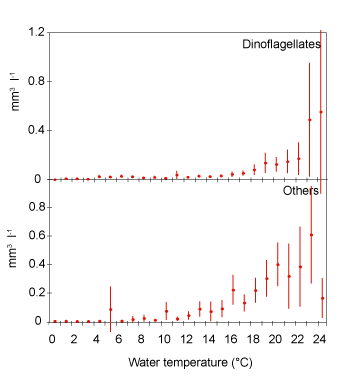 |
||
|
Temperature associated effects on biological lake processes |
||
|
Here, biological lake processes are represented by the development of algae, i.e. phytoplankton. Phytoplankton has the advantage that it quickly responds to changes in the catchment and weather. Taking 5110 sampling occasions in 127 Swedish lakes, the highest phytoplankton biomass was, on average, found when water temperature were warmest. Warmest water temperatures correspond to summer time in southern Sweden, and it might also correspond to a variety of other factors, e.g. most intensive agriculture and low water discharges. With this study it is not possible to differentiate between a direct and an indirect temperature effect. The following results should therefore be seen as a first evaluation. Further studies are necessary to test whether the relationships are direct or indirect in order to be able to explain underlying mechanisms. The increase of the phytoplankton biomass showed a varying increase with increasing temperatures (or temperature related variables). At water temperatures below 9 °C the increase in the total phytoplankton biomass was very small with, on average, 0.02mm3 l-1 per degree Celsius. Between 9 and 13 °C there was no dependency of the phytoplankton biomass on water temperatures and above 14 °C the phytoplankton biomass increased, on average, by 0.2 mm3 l-1 per degree Celsius. At the highest water temperatures cyanobacteria were dominant in the water (see figure). Cyanobacteria are known to bloom in warm, non-turbulent waters1,2,3 and it is likely that their biomass further increases with increasing water temperatures. Also dinoflagellates seem to steadily increase with increasing water temperatures, once 14 °C have been reached. In contrast to cyanobacteria and dinoflagellates other phytoplankton groups such as diatoms, cryptophytes and chlorophytes did not show their highest biomass at highest water temperatures (see figure). This implies that it is especially the phytoplankton composition that seems to be affected by increasing water temperatures. A clear change from a diatom dominated phytoplankton assemblages to a cyanobacteria dominated assemblages corresponds to environmental conditions where water temperatures are around 20°C (see figure).
|
Relationship between water temperature and a variety of phytoplankton groups (mean of 127 Swedish lakes and 5110 sampling occasions)
1 Reynolds, C. S. 1997. Vegetations processes in the pelagic: a model for ecosystem theory. In: Excellence in Ecology. Kinne, O. (ed.). Ecology Insitute, Oldendorf/Luhe, Germany. 2 Weyhenmeyer, G. A. 2001. Warmer winters: are planktonic algal populations in Sweden's largest lakes affected? Ambio 30: 565-571. 3 Wetzel, R. 2001. Limnology. Academic press, Elsevier USA. |
|


